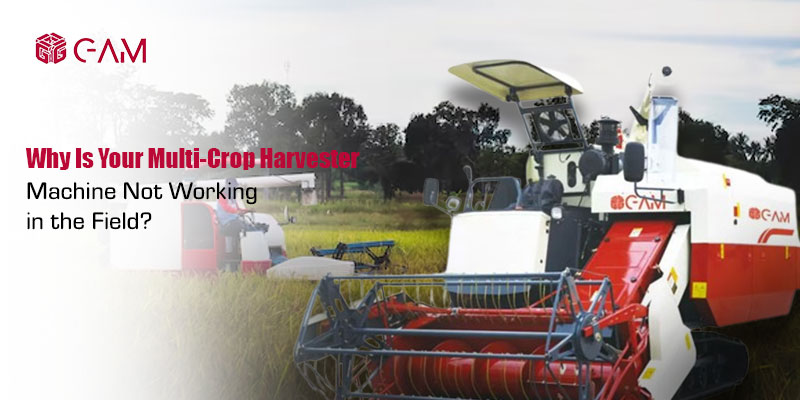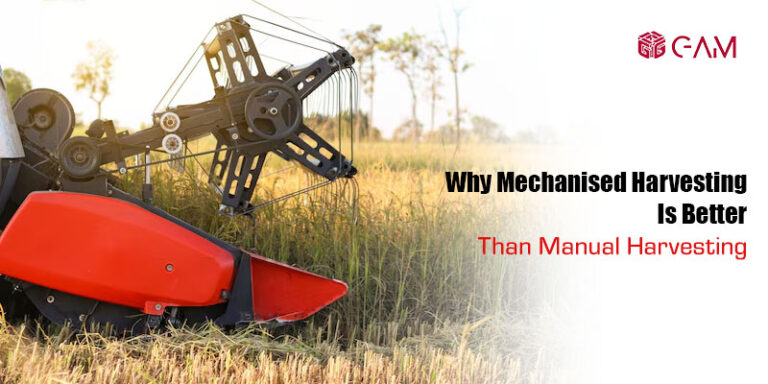You already know that a multi-crop harvester is a versatile agricultural machine that can harvest multiple crops with adjustable settings or detachable headers. It cuts, threshes and winnows, making harvesting easy with minimal manual effort. Not only does it cut the crop at ground level, but it also separates the grain or seed from the plant, removes chaff and debris, and finally collects the cleaned grain that can be used. The best part? It comes with interchangeable parts for various crops, such as a wheat header and a rice header.
But while modern farming is moving towards mechanisation to increase productivity, reduce overall labour dependence and quicken harvest efficiency, it may not be suitable. It may not work to its full potential. The reason? Probably the type of field you are harvesting in.
In this blog, we will help you discover more about the multi-crop machine, including where it works best and where it may not be the most suitable option. Continue reading with Godabari Agro to know more about it.
Where Can You Use a Multi-Crop Harvester?
To be honest, the real power of a multi-crop harvester lies in its compatibility with multiple crops. Here are the different types of crops that are compatible with Godabari Agro’s multi-crop harvester.
-
Cereal Crops
Crops like wheat, Rice (Paddy), Maize (Corn), Barley and Millets (Bajra, Jowar) are uniform, strong-stemmed and dry at the time of harvest. This is ideal for mechanical cutting and threshing.
-
Pulses
Pulses such as chickpeas (Chana), Green Gram (Moong), Black Gram (Urad), and Pigeon Pea (Arhar) require a gentle yet efficient threshing mechanism to prevent seed damage. Multi-crop harvesters can do this when adjusted properly without breaking a sweat!
-
Oilseeds
Finally, Oilseeds harvested with proper drum speed and sieves ensure clean output with minimal grain loss, so seeds like Mustard, Sunflower, Groundnut, and soybean are best suited for a multi-crop harvester.
Why Is Your Multi-Crop Harvester Not Working?
If you are facing common multi-crop harvester problems like crop jamming, improper grain separation, and engine overheating, the chances are that it is going through the following issues:
- Have the wrong header type
- No correct machine settings
- Using on wet terrains
- Finally, using it on the wrong crop.
Where You Should NOT Use a Multi-Crop Harvester
While multi-crop harvesters are versatile, they may not be suitable for everyone. Here are the crops you should not harvest with a multi-crop harvester:
-
Root & Tuber Crops
Root and tuber crops, such as Potatoes, Carrots, Sweet Potatoes, and Beetroots, grow underground and require diggers and lifters. So, using a crop-cutting harvester is of no use.
-
Delicate Fruits & Vegetables
Fruits and veggies like Tomatoes, Eggplants, Cucumbers and Pumpkins are soft, perishable crops that get crushed or damaged by the threshing drum of the harvester.
-
Leafy Vegetables
Green, leafy vegetables like Spinach, Coriander, Lettuce, Cabbage, and cauliflower require hand harvesting or low-impact cutting, which multi-crop harvesters can’t provide. Therefore, it’s clear that this is not the most suitable harvesting machine to use.
-
Tree-Borne Crops
Tree-borne crops like mangoes, Apples, Bananas, and coconuts need special equipment, such as pickers or climbers.
-
Specialty Crops
Finally, crops like Tea leaves, Coffee beans and Spices like cardamom and turmeric grow in hilly or shaded regions and need handpicking or niche harvesting equipment. A multi-crop harvester may not be the best choice for these crops either.
(Also read from our previous blogs: Why Investing in the Right Harvesting Equipment is Crucial for Crop Yield and Profit)
What Happens If You Use a Multi-Crop Harvester on Unsuitable Crops?
While multi-crop harvesters are known for their “all-in-one” features, they are not for every type of crop. Forcing them onto unsuitable crops can harm both the machine and your crops.
Here’s what happens:
- Machine Breakdown or Damage
Multi-crop harvesters are designed to cut and thresh standing crops. When used on root vegetables or delicate fruits, the machine’s cutting and threshing system may become jammed or clogged. Excessive strain on belts, chains and drums can cause mechanical failure. Dirt, mud, or sticky residues from the wrong crops can clog filters and damage bearings, potentially leading to costly repairs.
-
Grain Loss and Wastage
The next problem is that with incorrect drum speed, sieve size, or crop conditions, the seeds can become shattered, broken, or discarded along with the residue. So the essential parts of the crop may never reach the grain tank, which can affect your profit margins.
-
Increased Fuel and Time Wastage
Now, harvesting the wrong crop inefficiently means the machine has to work harder and longer to produce minimal results. So the fuel consumption will increase without proportional output. You will spend more time and money with nothing to show for it.
Bottom Line
There is no doubt that the multi-crop harvester is a wise choice for farmers or agricultural experts. However, despite its extraordinary functions, using it on unstable grounds or crop fields may lead to damage to both the machine and the crops. This is why a multi-crop harvester machine is best suited for paddy fields, rather than other types of fields. If this is your first time using a multi-crop harvester, it is recommended that you consult an expert, such as Godabari Agro.


